■瀬戸染付 Seto Sometsuke
「染付」とは、もともとは染織用語から派生した言葉です。
やきものの分野においては、酸化コバルトを含む顔料(呉須)で磁器の素地に下絵付けしたものを指します。(広義では陶器素地も含む)
“Sometsuke” is a word originally derived from the term for dyeing and weaving. In the field of pottery, it refers to underglaze painting on a porcelain base with a pigment containing cobalt oxide (gosu). (Broadly speaking, it also includes ceramic base)
染付がつくられるようになった正確な年代はわかっていませんが、デビッド・ファウンデーション所蔵の一対の瓶(紀年銘至正11(1351)年)の完成度や、1310年以降に沈没した新安沖貿易船の引き上げ品に染付が一点も含まれていない点などから考えて、14世紀前半代の中国でつくられるようになったと推測されています。
この頃の中国ではすでに白磁や釉下鉄絵がつくられており、染付がつくられる環境が整っていたと考えられます。
We do not know the exact time when sometsuke began to be made, but we can
see the degree of perfection of a pair of bottles owned by the David Foundation
(dated 1351), and the sunken Shinan jars after 1310. Considering the fact
that none of the items brought up from the offshore trade ship contained
dyeing, it is speculated that they began to be made in China in the first
half of the 14th century.
At this time in China, white porcelain and glazed iron paintings were
already being made, and it is thought that the environment for dyeing was
already in place.
そして15世紀の大航海時代に入ると染付を含むたくさんの中国陶磁がアラビア商人を介して海上輸送により世界中に運ばれたと考えられており、今日でもそのルート沿いにはたくさんの中国陶磁が残されています。
その中でも特に有名なのがトルコ・イスタンブールにあるトプカプ宮殿のコレクションです。
In the 15th century, during the Age of Discovery, it is believed that many Chinese ceramics, including sometsuke, were transported all over the world by sea via Arabian merchants. left.
Among them, the collection of Topkapi Palace in Istanbul, Turkey is particularly famous.
中国の染付を手に入れた世界各地で、この美しいやきものを自国で生産しようとする動きが起こり始めました。
日本国内では、17世紀初めに九州・有田地方において磁器の製造に成功しました。その後技術は急速に向上し、その品質は中国に肩を並べるほどになっていきました。
そして17世紀中期には、明時代末期の動乱のために中国からの輸入が途絶えたヨーロッパ向けに、その代わりとして有田の磁器が盛んに輸出されていきました。これらのやきものはその輸出港であった伊万里津の名前を取って、伊万里焼と呼ばれるようになりました。
In many parts of the world that acquired Chinese sometsuke, a movement
to produce this beautiful pottery in their own countries began to emerge.
In Japan, at the beginning of the 17th century, we succeeded in manufacturing porcelain in the Arita region of Kyushu. After that, the technology improved rapidly, and the quality came to rival that of China.
In the middle of the 17th century, porcelain from Arita began to be actively exported to Europe, where imports from China had ceased due to the upheaval at the end of the Ming Dynasty. These potteries came to be called Imari ware, taking the name of the port of export, Imari Tsu.
一方、瀬戸では九州で磁器の生産が始まった17世紀以降、磁器の人気に対抗するため、素地をできるだけ白くした陶器に絵付を施すなど様々な試みがなされています。
やがて、有田に遅れること約二百年後の19世紀初めには瀬戸でも磁器の製造に成功します。
On the other hand, in Seto, since the 17th century when the production
of porcelain began in Kyushu, various attempts have been made to compete
with the popularity of porcelain, such as painting the base as white as
possible.
In the early 19th century, about 200 years after Arita, Seto also succeeded
in manufacturing porcelain.
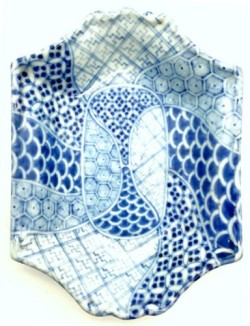 瀬戸の加藤民吉が九州から丸窯や柞灰(いすばい)の使用などを伝えたことで瀬戸の磁器の生産技術は飛躍的に進歩し、以降、染付が中心となって瀬戸の発展を支えることとなりました。
瀬戸の加藤民吉が九州から丸窯や柞灰(いすばい)の使用などを伝えたことで瀬戸の磁器の生産技術は飛躍的に進歩し、以降、染付が中心となって瀬戸の発展を支えることとなりました。
Tamikichi Kato of Seto introduced the use of round kilns and ash from Kyushu,
and the production technology of Seto porcelain made rapid progress. has
supported the development of
瀬戸染付の特徴は山水・花鳥・草花等がより写実的、より繊細に描かれ、その趣は文様中心といった他の産地のものとは異なり、独特の世界を持っていることです。
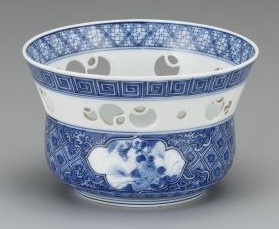 没骨(もっこつ)技法と呼ばれる、主に付立筆を用いて一気に描く技法が取り入れられ、瀬戸を訪れた南宋風の絵師から絵付けの指導を受け、今日の瀬戸染付の基礎が確立されました。
没骨(もっこつ)技法と呼ばれる、主に付立筆を用いて一気に描く技法が取り入れられ、瀬戸を訪れた南宋風の絵師から絵付けの指導を受け、今日の瀬戸染付の基礎が確立されました。
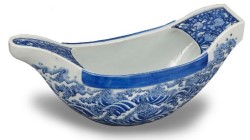 砂婆(さば)と呼ばれる風化した花崗岩に木節粘土・蛙目粘土などを混ぜたやわらかな味わいを持つ素地に、藍色を主とした色彩で、自然画・鳥・花などが繊細かつリアルな筆で描かれています。
砂婆(さば)と呼ばれる風化した花崗岩に木節粘土・蛙目粘土などを混ぜたやわらかな味わいを持つ素地に、藍色を主とした色彩で、自然画・鳥・花などが繊細かつリアルな筆で描かれています。
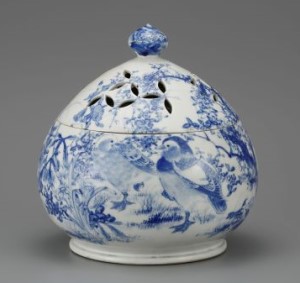 染付とは一般的には磁器のものを指しますが、瀬戸染付はその前身となった陶胎染付(陶器への染付)も行われており、陶器・陶磁器への染付という独特な味わいに人気があります。
染付とは一般的には磁器のものを指しますが、瀬戸染付はその前身となった陶胎染付(陶器への染付)も行われており、陶器・陶磁器への染付という独特な味わいに人気があります。
The characteristics of Seto Sometsuke are that landscapes, flowers, birds,
flowers, etc. are drawn more realistically and delicately, and the taste
is different from other production areas such as patterns, and has a unique
world.
A technique called Mokkotsu technique, which is mainly used to paint with
brushes, was adopted, and the foundation of today's Seto dyeing was established
by receiving painting guidance from Southern Song-style painters who visited
Seto. it was done.
Weathered granite called saba is mixed with Kibushi clay, Gairome clay, and other clays to give it a soft texture. The main color is indigo, and the natural paintings, birds, and flowers are delicate and realistic. drawn with a brush.
Sometsuke generally refers to porcelain, but the predecessor of Seto Sometsuke,
Totai Sometsuke (sometsuke on pottery), is also called Sometsuke on pottery
and ceramics. It is popular for its unique taste.
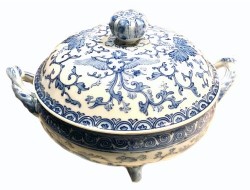 明治時代盛んに行われた海外万国博覧会での瀬戸染付の評価は大変に高く、写実的に自然の文物を描いた文様はフランスで始まったアール・ヌーヴォーに影響を与えたともいわれています。
明治時代盛んに行われた海外万国博覧会での瀬戸染付の評価は大変に高く、写実的に自然の文物を描いた文様はフランスで始まったアール・ヌーヴォーに影響を与えたともいわれています。
Seto Sometsuke was highly evaluated at international expositions held overseas
during the Meiji period, and it is said that the realistic depiction of
natural objects influenced Art Nouveau, which began in France. .
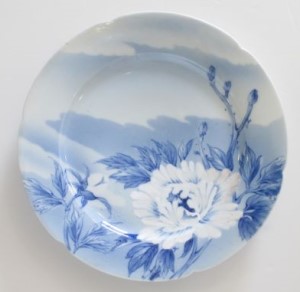 時代が移り、大量生産のための機械化・省力化が進み、石膏型による鋳込成形や銅版・プリントによる絵付などが発達したことによって、伝統的な瀬戸染付の技術は一時途絶えかけました。
時代が移り、大量生産のための機械化・省力化が進み、石膏型による鋳込成形や銅版・プリントによる絵付などが発達したことによって、伝統的な瀬戸染付の技術は一時途絶えかけました。
As the times changed, mechanization and labor-saving progressed for mass
production, casting with plaster molds and painting with copperplates and
prints developed, and the traditional Seto Sometsuke technique almost died
out for a while. .
しかし近年の心の豊かさを求める傾向が強まったことなどにより、手作り・手描きのよさが再び評価されつつあります。そうした流れの中で、瀬戸染付に今後さらなる発展が期待されているところです。
However, in recent years, due to the growing tendency to seek spiritual
richness, the quality of hand-made and hand-painted products is being evaluated
again. In such a trend, further development is expected for Seto Sometsuke
in the future.
■主な技法 Main Technique
瀬戸染付の主な技法として
①細い筆で輪郭線を描く「骨書き(こつがき)」
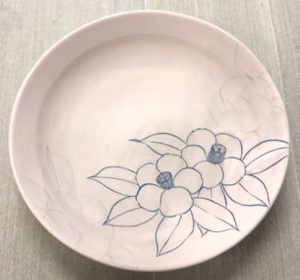
②太い筆で濃淡・グラデーションを描く「濃み(だみ)」
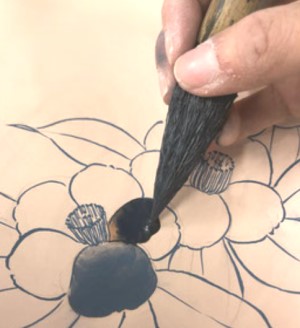
③輪郭なしで筆のふくらみや勢いを生かして描く「付立て(つけたて)」
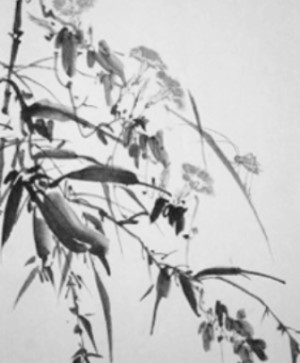
があります。
伝統的な瀬戸染付は②濃み&③付立て技法を用いて、花鳥風月や山水が数多く描かれました。
■染付年表 Chronology
| 1335~1367 (至元・至正年間) |
中国元朝において染付の製法が確立。 |
|---|---|
| 1369(洪武2年) | 中国明朝、朝廷用祭器に磁器を用いることを勅令。 |
| 1427(応永34年) | 日本の文献に初めて『茶碗染付」の語が表れる。 |
| 1615~1624 (元和年間) |
肥前有田で李参平が日本最初の染付磁器を試作。 |
| 1712(正徳2年) | 肥後天草で良質の磁器石・天草陶石発見。 肥後天草で良質の磁器石・天草陶石発見。 |
| 1781~1789 (天明年間) |
品野の窯屋、加藤粂八が肥前から逃亡してきた磁工久米勇七(副島勇七・加々良勇七とも伝えられる)に従い、磁器・上絵付の製法を習得。 |
| 1789(寛政元年) | 加藤粂八と北新谷の窯屋・六代加藤忠治が共同で磁器を試造。 |
| 1801(享和元年) | 加藤吉左衛門・民吉親子が熱田奉行津金文左衛門の指導の下、磁器を試造。 津金文左衛門が熱田古堤に染付焼窯を築窯。 加藤唐左衛門が熱田古堤の窯を廃止を嘆願。瀬戸にて新製染付焼開始。 尾張藩が瀬戸窯屋の嫡子のみに限った相続を磁器には適用しない旨通知。 加藤吉左衛門、六代加藤忠治ら14名が磁器に転業。 |
| 1802(享和2年) | 御蔵会所設置。 |
| 1803(享和3年) | 尾張藩の援助で磁器焼造用丸窯を築窯。 二代川本治兵衛が染付磁器の素地配合に成功。 染付磁器が尾張藩の蔵物に定められる。 六代加藤忠治が尾張藩に染付磁器十二俵を納める。 |
| 1804(享4年) | 加藤民吉が摂津三田窯を視察。 |
| 1804(文化元年) | 加藤民吉が九州へ出立。天草、三川内にて磁器製法・丸窯などについて知識を習得。 尾張藩勘定奉行により、染付蔵物に押印される「尾張」の木印が下される。 加藤吉左衛門が本業焼併新製焼取締役に就任。 |
| 1807(文化4年) | 加藤民吉が瀬戸に帰着。 |
| 1812(文化9年) | 加藤唐左衛門が新製焼取締役に就任。 |
| 1814(文化11年) | 加藤唐左衛門が上半田川村にて良質の千倉を発見。 |
| 1818(文政1年) | 二宮守恒が加藤民吉に取材し「染付焼起源」を著す。 |
| 1826(文政9年) | 加藤民吉、窯神神社に合祀。 |
| 1839(天保10年) | 三代川本治兵衛が銅版染付を試造。 |
| 1845(弘化2年) | 四代川本半助が染付磁器の素地・釉薬にギヤマン(珪石)を加え、品質の向上を図る。 |
| 1849(嘉永2年) | 三代川本治兵衛が美濃伊岐津村にて良質の磁土・イギ土(カオリン)を発見。 |
| 1848~1854 (嘉永年間) |
三代加藤新七が名古屋川名にて銅版染付専業窯を開く。 |
| 1858(安政5年) | 三井組、加藤兼助らに輸出用磁器の見本製作を依頼。この頃に赤津から蛙目粘土の産出が確認。 |
| 1861(文久元年) | 名古屋川端筋の「角吉」が瀬戸にアメリカ向けのコーヒーカップ等を発注。 |
| 1863(文久3年) | 再び三井組の依頼で輸出見本数種が製作される。 |
| 1867(慶應3年) | 瑞穂屋清水卯三郎(東京)がパリより、酸化コバルト等陶磁器顔料を持ち帰る。 |
| 1871(明治4年) | この頃、田代安吉(有田)を通じて、瀬戸に酸化コバルトがもたらされる。 この頃までに、肥前志田窯にて摺絵技法再興。 |
| 1872(明治5年) | 二代加藤周兵衛が澳国博覧会出品青華製造取締役に任命される。 |
| 1873(明治6年) | 愛知郡山口(現瀬戸市)にて良質の蛙目粘土発見。 |
| 1874(明治7年) | 松村九助(有田・名古屋)を通じて、瀬戸に酸化コバルトの使用法がもたらされる。 輸出用コーヒー碗の生産始まる。 ウィーン万博派遣の伝習生がヨーロッパより直焔式丸窯などの技術を持ち帰る。 |
| 1875(明治8年) | 加藤五助・川本桝吉らが加藤友太郎・川本富太郎より石膏型の製法を伝授される。 |
| 1883(明治16年) | 加藤紋右衛門ら113人からなる瀬戸村磁工組合設立。 森村組(現ノリタケ)、川本桝吉に コーヒーカップの見本を示しその製作を依頼。わが国最初の六人具の製作。瀬戸陶磁工組設立。 |
| 1887(明治20年) | 加藤繁十が素焼窯考案。 五十嵐健二(土岐)が白笈を使用した銅版下絵を考案。 |
| 1889(明治22年) | 加藤米次郎・元次郎(多治見)が銅版下絵の特許取得。 大倉孫兵衛(東京)がゴム印絵付法を欧米から持ち帰る。 |
| 1894(明治27年) | 名古屋陶磁器貿易組合設立。瀬戸陶磁工組と名古屋陶磁器貿易商組合と連合交渉会議規約を締結。 |
| 1896(明治29年) | 松村八次郎(名古屋)が純白硬質磁器の特許取得。 |
| 1899(明治32年) | 瀬戸陶磁器工商同業組合設立。 |
| 1902(明治35年) | 黒田政憲の指導の下、瀬戸陶磁器試験場に石炭窯を築くが失敗。 松村八次郎が松村式石炭窯(倒焔両焚式一間窯)を発明。 |
| 1904(明治37年) | 森村組が純白硬質磁器の量産を試みる。 |
| 1909(明治42年) | 北村弥一郎の指導の下、フランス式石炭窯を築く。 名古屋陶磁器貿易商工同業組合設立。 |
| 1925(大正14年) | 5月20日窯神神社が放火により全焼。 |
| 1926(大正15年) | 10月21日瀬戸陶磁器工業組合(現、愛知県陶磁器工業協同組合)設立。 |
| 1927(昭和2年) | 10月民吉に取材した歌舞伎「明暗縁の染付」大阪中座にて初演。 |
| 1928(昭和3年) | 11月10日津金文左衛門に正五位、加藤民吉に従五位が追贈。 |
| 1932(昭和7年) | 日本陶器(現ノリタケ)ボーンチャイナの製造開始。 |
| 1937(昭和12年) | 9月瀬戸初の銅像として磁祖加藤民吉像が窯神山に建立。 12月8日「尾張磁器発祥の地」碑建立。 3月「津金親子頌徳碑」建立。 |
| 1958(昭和33年) | 3月29日瀬戸染付着画の技術(保持者、山田良治)が愛知県指定無形文化財に認定。 |
| 1972(昭和47年) | 9月4日染付磁器技術(保持者、河本礫亭)が愛知県指定無形文化財に認定。 |
| 1994(平成7年) | 2月13日陶芸瀬戸染付技法(保持者、加藤靖彦氏)が瀬戸市指定無形文化財に認定。 |
| 1997(平成9年) | 瀬戸染付焼が通産省指定伝統工芸品に認定。 |
| 2000(平成12年) | 「瀬戸市マルチメディア伝承工芸館 ―瀬戸染付研修所―」開設。 |
| 2007(平成19年) | 当館の古窯が経済産業省の「近代化産業遺産」に認定。 |
| 2014(平成24年) | 「瀬戸染付工芸館」へ名称変更。 |
« TOPへ戻る